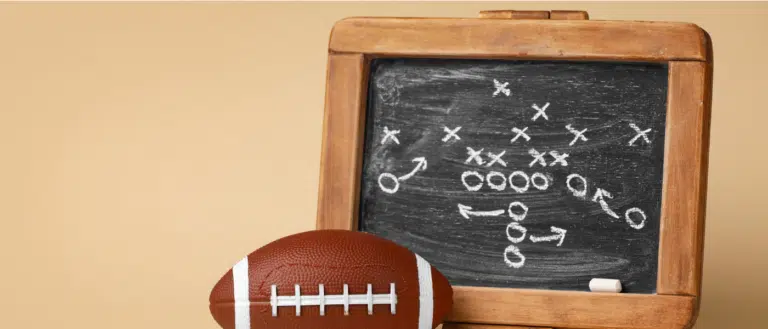Building Lineup Stacks In DFS Analyzed: Should You Do It?

Once you enter the world of daily fantasy sports, you will quickly start to hear about “lineup stacks”. Lineup stacking is a core concept of DFS that is necessary to learn if you want to become a winning Guaranteed Prize Pool (GPP) player.
 Play $5, Get $50PrizePicks Promo Code: BUSA
$50 provided as promo funds, only for use on PrizePicks. Promo funds provided under this promotion must be played within 90 days of receipt or shall become null and void at PrizePicks’ discretion. Promo ends 12/31/25. Void where prohibited. If you or someone you know has a gaming problem, get help. Crisis services and responsible gaming counseling can be accessed by calling 1-800-426-2537 or online at www.ncpgambling.org. 18+ in most eligible jurisdictions, but other age and eligibility restrictions may apply. Valid only in jurisdictions where PrizePicks operates. See prizepicks.com/terms for full PrizePicks terms of service.
Play $5, Get $50PrizePicks Promo Code: BUSA
$50 provided as promo funds, only for use on PrizePicks. Promo funds provided under this promotion must be played within 90 days of receipt or shall become null and void at PrizePicks’ discretion. Promo ends 12/31/25. Void where prohibited. If you or someone you know has a gaming problem, get help. Crisis services and responsible gaming counseling can be accessed by calling 1-800-426-2537 or online at www.ncpgambling.org. 18+ in most eligible jurisdictions, but other age and eligibility restrictions may apply. Valid only in jurisdictions where PrizePicks operates. See prizepicks.com/terms for full PrizePicks terms of service.
Stacking is something that is generally done in GPPs for upside, so assume that is what I am referring to throughout unless stated otherwise. You can read more about building lineups for other lineups in my previous piece here.
A “stack” uses players from the same team or game to create a correlation in your lineup. For example, you want your hitters to score runs and get as many at-bats as possible. Using multiple players from the same team increases the likelihood that they all do well.
If you do hit on the highest-scoring teams and games, it usually puts you in a great spot to hit a top-end placing in GPPs. In most sports, players use this to limit and capitalize on variance. It would be great to play eight hitters that hit a home run from different teams, but that is almost impossible.
Football DFS Stacks
Stacking in football is very useful, and it might be one of the most under-utilized concepts in NFL DFS. The most common stack in football DFS is the quarterback to pass catcher stack. The other commonly used stack is the running back paired with the defense.
People want to use a wide receiver or tight end with their quarterback because they are intricately related. If the quarterback has a great game, it is very likely that the #1 or #2 wide receiver on that team also does well, which saves you the effort of hunting for great individual performances.
I think these DFS stacks are under-utilized because people are scared to play 2, 3, or even 4 skill position players with their quarterback since they believe that it is too much. That said, we have seen five-man DFS stacks win the million-dollar contests on major DFS sites before, and it is because they are heavily correlated.
If Baker Mayfield and Odell Beckham Jr. are having a great day, it doesn’t mean that Jarvis Landry, David Njoku, and Nick Chubb can’t too. If the Browns score five touchdowns and gain 500 yards on the day vs. a horrible defense, all five of these players can hit, though almost everyone is too scared to play this combination.
Four skill position players is a bit extreme because it is hard to feed all of them enough for them to all be fantastic, especially depending on price. The thing to understand is that even incredibly elite lineups often have a weak spot or two depending on the week.
Everyone is worried about getting maximum upside from every spot, and using Jarvis, Beckham, and Njoku and hoping they get there means that it’s really unlikely that OBJ scores three TDs like you want him to. This is actually what runs through a lot of people’s minds, and you need to take advantage of using bigger stacks in football.
In modern-day football, we are seeing a massive increase in production from tight ends on any given day, along with the same thing from running backs. Everyone is terrified to use Drew Brees with Alvin Kamara and Michael Thomas, but it really isn’t justified.
If Drew Brees and Michael Thomas are having a great game, that is something like 11 catches for 118 yards and a touchdown. That could very well be WR1 on the entire week.
People are scared of playing Kamara in their lineup along with Brees and Thomas for some reason. Kamara could rack up 89 rushing yards and 66 receiving yards on five catches and a touchdown receiving and rushing if he’s played, but people balk at the idea without any good reason. Again, that line has the potential to be RB1 on the entire slate.
Are those guys really poaching from each other’s success? Not really, as those stats only account for 16 completions for 184 yards, 89 rushing yards, and three total touchdowns.
We can even throw Ted Ginn in with five catches for 88 yards and a touchdown at a cheap price to be a great value. That gives Brees 272 yards and three TDs.
None of those players’ totals are even close to out of the realm of possibilities. We have seen 50 point games with 6 or 7 touchdowns scored in them; this is just a four-TD game for the Saints with four elite fantasy players.
Don’t trick yourself into thinking you are losing a bunch of upside if you use 3, 4, or 5 players from one team in the NFL.
You can also game stack many other ways in football. You can use a running back from one team and the QB + pass-catching option(s), in an attempt to guess the game script where one team gets a big lead and then forces the other to play catch-up.
You can also stack a shootout. This is something that I love doing in college football DFS because we tend to see massive totals on both sides, and we can roster 2 QBs on most sites.
When one team scores easily and quickly, it gives the other team more chances to score coming back. Not to mention that fast-paced games are often more of a hindrance to the defense due to the energy exerted. We see games like the Rams vs. Chiefs and Oklahoma vs. West Virginia produce 8-10 elite fantasy options, which is what you are hoping for in a full-game stack.
Another note is that you should NOT be timid about stacking against your defense. In GPP contests, you are looking for a defense with upside, not one that will allow 0 points.
A great example of this is in the Rams vs. Chiefs week 11 game last season. The Rams defense allowed 51(!!!) points and scored 21 fantasy points due to fumbles, interceptions, sacks, and touchdowns.
Basketball DFS Stacks
I generally try to avoid stacking in the NBA on large slates. This is all dependent on pricing because there are injury situations where teams are just too cheap at four different spots to resist.
The primary purpose of stacking in most sports is to look for outliers and correlation. If Aaron Judge has 7 RBIs, it’s likely that he hit in four guys from the Yankees lineup. They all benefited from his elite performance.
In basketball, you usually take points away from teammates more than you are adding on to them. There is a correlation in assists and points, but it is not a huge deal. On major slates, there is rarely going to be a game where five guys from one game all make the best lineup.
This is because the range of points scored in a basketball game is much less unless there is overtime. A really slow basketball game total is 200, and a really high one is 240, and we don’t see actual results stray from those numbers very much. A fast game may result in more misses, rebounds, steals, but it’s still not as big as other sports.
In other sports, the Rams might score 0 points, and they might score 45. In basketball, the Raptors may score 102 or 122, but that’s not a huge deal to the fantasy production of an individual player.
If I do use more than two players from a team, I almost always want to have another guy coming back from the other side in case it does go to overtime or does play really fast. This doesn’t have to be the case if it is three cheap options that are more price plays than anything. If I am playing James Harden, Clint Capela, and P.J. Tucker, I would really like to get at least one guy in from the team they are facing.
I prefer stacking on smaller slates because one game can be THAT much better than the other three much more often than the other 12 games. It also gives you the potential to hit big if you magically get a 3-OT game.
Baseball DFS Stacks
This sport involves the most stacking, and I still think it is not used enough. You should stack in baseball GPPs 90+% of the time, and I stack 100% of the time.
There is not really firm data throughout the industry to prove which stack is the absolute best, but it depends on the day. The more people you use from one team, the more correlation you bring to a lineup, which is why I almost always use five-man stacks on DraftKings and four-man stacks on FanDuel DFS to maximize my correlation.
After the maximum stack, I determine which stacks I like that day, depending on my general lineup builds. On a night when I like a lot of cheap or expensive arm combinations, I am more likely to use the remaining spots for individual hitters that grade out well. This is because using two cheap or expensive pitchers together limits the different 3- or 2-man stacks I can use.
When I want to play Max Scherzer and Noah Syndergaard together on a two-pitcher site, I will likely not have many great stack options because I won’t have much money on the table. I don’t want to be forced into a choice between the Blue Jays 6-8 stack or the Orioles’ 5, 7, and 9 hitters to fill out my three-man stacks, so I prefer to use individual cheap plays.
If I like a lot of pitching options, I will try to use more 2- or 3-man stacks because I should be able to get a lot of variation throughout these lineups.
Another common mistake that I see people make in baseball stacking is trying to force the top of the order or forcing the specific 1-5 stack. I almost prefer the 2, 4, 5, 7, and 8 hitter stack that works better with my lineup than the very typical construction. Baseball is very random, so you must embrace the variance.
Hockey And Soccer DFS Stacks
These sports have a very similar setup to baseball when it comes to creating lineups. Stacking in soccer is unnecessary, but it can be very useful if there is a team with a big game. Obviously, when the U.S. Women’s team wins 13-0, every team at the top of the leaderboards is full of that team.
This is because, for most goals, there is a very valuable assist. Pairing those two players together can be difficult, but it becomes a lot easier if you can get 4 or 5 goals out of it.
Hockey is very similar to baseball, but the people you pair together matter more. When I am stacking a hockey team, I am always making sure those players are on the same line or the same power play. This correlation allows you to get two assists and a goal from one goal, quickly vaulting you up the leaderboards.
Golf DFS Stacks
The only stacks that I implement in golf are tee time stacks. 3-10 events a year have a significant weather edge.
I mean that the players who play early or late on day 1 have a drastic advantage due to the weather on Thursday and Friday. Sometimes the weather edge is clear, but other times it is not.
For example, there are major winds on Thursday afternoon and Friday morning, but there is also a good chance for rain. It is likely that play will be delayed at some point, and we have no idea who will be playing in the wind.
When that is the case, I often stack both sides of the draw to give myself a chance if either tee time does get a significant advantage.
MMA DFS Stacks
This is the only sport where stacking ONLY makes sense in cash games. Stacking in other sports increases your variance, but not in MMA. The point of stacking in cash in MMA is usually for salary relief or safety.
In MMA, the main event is five rounds, meaning that it has the potential to be higher scoring. This is why you rarely see players stack anything besides five-round fights.
Stacking for salary relief often occurs when you have a mismatch in the main event that is incredibly expensive and popular. You can play that fighter and their opponent, who will be very cheap. To win cash games in MMA, you don’t need to win all six fights, and you can even get away with a 4-2 night.
If you play both fighters, you are guaranteed a win, and you will get a big-time score for the average price of both fighters. You play the chalk option, cover yourself if they win or lose, and you get salary relief to pick four more winners on the card to secure the cash.
Stacking for safety is usually important in a tightly contested main event. If fighter A is going to be 55% owned and fighter B is going to be 40% owned, do you really want to risk your entire night on that fight? Just take both sides, guarantee a win, and pick four winners with an increased salary.
I do not stack at all at DraftKings Tennis Daily Fantasy contests or NASCAR.







